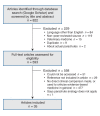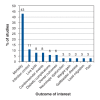Most medical practices are not parachutes: a citation analysis of practices felt by biomedical authors to be analogous to parachutes
- PMID: 29343497
- PMCID: PMC5878948
- DOI: 10.9778/cmajo.20170088
Most medical practices are not parachutes: a citation analysis of practices felt by biomedical authors to be analogous to parachutes
Abstract
Background: In a 2003 paper in BMJ, the authors made the tongue-in-cheek observation that there are no randomized controlled trials (RCTs) of parachutes. This paper has been widely read, cited and used to argue that RCTs are impractical or unnecessary for some medical practices. We performed a study to identify and evaluate claims that a medical practice is akin to a parachute.
Methods: Using Google Scholar, we identified all citations to the 2003 paper. We searched for claims that a specific practice was akin to a parachute. For each practice, we identified the desired outcome of the practice, and searched Google Scholar and ClinicalTrials.gov for RCTs that were conducted, ongoing, halted, planned or unpublished.
Results: Of 822 articles citing the original paper, 35 (4.1%) argued that a medical practice was akin to a parachute. Eighteen of the 35 (51%) concerned mortality or live birth, and 17 (49%) concerned a lesser outcome. For 22 practices (63%), we identified 1 or more RCTs: in 6 cases (27%), the trials showed a statistically significant benefit of the practice; in 5 (23%), the trials rejected the practice; in 5 (23%), the trials had mixed results; in 2 (9%), the trials were halted; and in 4 (18%), the trials were ongoing. Effect size was calculated for 5 of the 6 practices for which RCTs gave positive results, and the absolute risk reduction ranged from 11% to 30.8%, corresponding to a number needed to treat of 3-9.
Interpretation: Although there is widespread interest regarding the BMJ paper arguing that randomized trials are not necessary for practices of clear benefit, there are few analogies in medicine. Most parachute analogies in medicine are inappropriate, incorrect or misused.
Copyright 2018, Joule Inc. or its licensors.
Conflict of interest statement
Competing interests: Sham Mailankody has received honoraria from Wedbush PacGrow for speaking at the annual health care conference and from PleXus Communications for continuing medical education activity. Vinay Prasad is funded by the Laura and John Arnold Foundation. No other competing interests were declared.
Figures
Similar articles
-
The use and meaning of the parachute metaphor in biomedicine: a citation analysis of a systematic review and a randomized trial of the parachute for freefall.J Comp Eff Res. 2022 Apr;11(6):383-390. doi: 10.2217/cer-2021-0171. Epub 2022 Feb 22. J Comp Eff Res. 2022. PMID: 35189694
-
Systematic reviews of the effectiveness of day care for people with severe mental disorders: (1) acute day hospital versus admission; (2) vocational rehabilitation; (3) day hospital versus outpatient care.Health Technol Assess. 2001;5(21):1-75. doi: 10.3310/hta5210. Health Technol Assess. 2001. PMID: 11532238 Review.
-
Parachute use to prevent death and major trauma related to gravitational challenge: systematic review of randomised controlled trials.Int J Prosthodont. 2006 Mar-Apr;19(2):126-8. Int J Prosthodont. 2006. PMID: 16602356
-
Analysis of Orthopaedic Research Produced During the Wars in Iraq and Afghanistan.Clin Orthop Relat Res. 2015 Sep;473(9):2777-84. doi: 10.1007/s11999-015-4244-7. Clin Orthop Relat Res. 2015. PMID: 25758377 Free PMC article.
-
A systematic examination of the citation of prior research in reports of randomized, controlled trials.Ann Intern Med. 2011 Jan 4;154(1):50-5. doi: 10.7326/0003-4819-154-1-201101040-00007. Ann Intern Med. 2011. PMID: 21200038
Cited by
-
Comparing the diagnostic considerations between general practitioners with a special interest in cardiovascular disease and those without in patients with symptoms suggestive of heart failure: a vignette study.BMC Prim Care. 2024 Jun 14;25(1):216. doi: 10.1186/s12875-024-02466-6. BMC Prim Care. 2024. PMID: 38877394 Free PMC article.
-
Adventures With Andexanet Alfa in Efficacy, Effectiveness, and One-Armed Studies: May 2019 Annals of Emergency Medicine Journal Club.Ann Emerg Med. 2019 May;73(5):545-547. doi: 10.1016/j.annemergmed.2019.03.015. Ann Emerg Med. 2019. PMID: 31029291 Free PMC article.
-
Pulmonary Metastasectomy in Colorectal Cancer (PulMiCC) randomized controlled trial: a systematic review of published responses.Eur J Cardiothorac Surg. 2022 Jun 15;62(1):ezac253. doi: 10.1093/ejcts/ezac253. Eur J Cardiothorac Surg. 2022. PMID: 35415756 Free PMC article.
-
COVID-19 false dichotomies and a comprehensive review of the evidence regarding public health, COVID-19 symptomatology, SARS-CoV-2 transmission, mask wearing, and reinfection.BMC Infect Dis. 2021 Jul 27;21(1):710. doi: 10.1186/s12879-021-06357-4. BMC Infect Dis. 2021. PMID: 34315427 Free PMC article. Review.
-
Sensible Introduction of MR-Guided Radiotherapy: A Warm Plea for the RCT.Front Oncol. 2021 Mar 19;11:652889. doi: 10.3389/fonc.2021.652889. eCollection 2021. Front Oncol. 2021. PMID: 33816308 Free PMC article.
References
-
- Cunningham A. A highest fall survived without a parachute. In: Guinness World Records 2002. London (UK): Guinness World Records; 2001.
-
- Injury/fatality rates. Leicester (UK): British Parachute Association; 2007. [accessed 2016 Apr. 17]. Available www.bpa.org.uk/staysafe/how-safe/
-
- Hook CC, DiMagno EP, Tefferi A. Primer on medical genomics. Part XIII: Ethical and regulatory issues. Mayo Clin Proc. 2004;79:645–50. - PubMed
-
- Pereira TV, Horwitz RI, Ioannidis JP. Empirical evaluation of very large treatment effects of medical interventions. JAMA. 2012;308:1676–84. - PubMed
LinkOut - more resources
Full Text Sources
Other Literature Sources
Molecular Biology Databases


